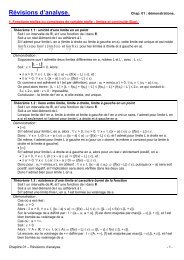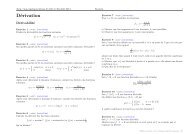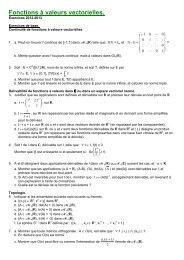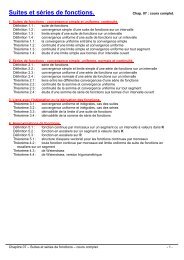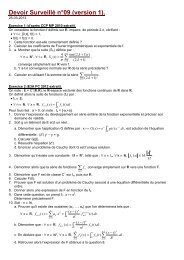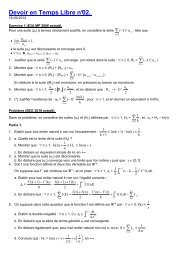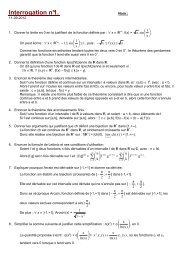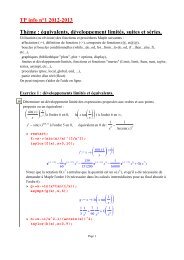Système de Cramer
Système de Cramer
Système de Cramer
You also want an ePaper? Increase the reach of your titles
YUMPU automatically turns print PDFs into web optimized ePapers that Google loves.
[http://mp.cpgedupuy<strong>de</strong>lome.fr] édité le 26 juillet 2013 Corrections 2<br />
Corrections<br />
Exercice 1 : [énoncé]<br />
a) On a <br />
1 1 1<br />
a b c<br />
a 2 b 2 c 2<br />
<br />
<br />
<br />
<br />
= (b − a)(c − a)(c − b) = 0<br />
<br />
Par les formules <strong>de</strong> <strong>Cramer</strong><br />
⎧<br />
(b − d)(c − d)(c − b)<br />
x =<br />
(b − a)(c − a)(c − b)<br />
⎪⎨<br />
(d − a)(c − a)(c − d)<br />
y =<br />
(b − a)(c − a)(c − b)<br />
⎪⎩<br />
(b − a)(d − a)(d − b)<br />
z =<br />
(b − a)(c − a)(c − b)<br />
b) On a <br />
1 1 1<br />
a b c<br />
a 3 b 3 c 3<br />
Par les formules <strong>de</strong> <strong>Cramer</strong><br />
et y, z par symétrie.<br />
x =<br />
<br />
<br />
<br />
<br />
= (b − a)(c − a)(c − b)(a + b + c) = 0<br />
<br />
(b − d)(c − d)(c − b)(d + b + c)<br />
(b − a)(c − a)(c − b)(a + b + c)<br />
Exercice 2 : [énoncé]<br />
Le système est <strong>de</strong> <strong>Cramer</strong> via déterminant <strong>de</strong> Van<strong>de</strong>rmon<strong>de</strong>.<br />
(1) + (2) + (3) donne<br />
(1) + j 2 (2) + j(3) donne<br />
et (1) + j(2) + j 2 (3) donne<br />
x =<br />
a + b + c<br />
3<br />
y = a + bj2 + cj<br />
3<br />
z =<br />
a + bj + cj2<br />
3<br />
Exercice 3 : [énoncé]<br />
Le déterminant du système est<br />
<br />
<br />
1 a a<br />
<br />
<br />
<br />
2<br />
ā 1 a<br />
ā2 <br />
<br />
<br />
<br />
<br />
ā 1 =<br />
<br />
<br />
<br />
1 a a<br />
<br />
<br />
<br />
2<br />
0 1 − |a| 2<br />
a(1 − |a| 2 )<br />
0 ā(1 − |a| 2 ) 1 − |a| 4<br />
<br />
<br />
<br />
<br />
<br />
=<br />
<br />
<br />
<br />
<br />
<br />
<br />
Si |a| = 1 alors est le système est <strong>de</strong> <strong>Cramer</strong> et homogène<br />
S = {(0, 0, 0)}<br />
Si |a| = 1 alors le système équivaut à une seule équation<br />
x + ay + a 2 z = 0<br />
car les <strong>de</strong>ux autres lui sont proportionnelles. On en déduit<br />
S = (−ay − a 2 z, y, z)/y, z ∈ C <br />
1 a a 2<br />
0 1 − |a| 2 a(1 − |a| 2 )<br />
0 0 1 − |a| 2<br />
Exercice 4 : [énoncé]<br />
Les <strong>de</strong>ux systèmes proposés sont <strong>de</strong> <strong>Cramer</strong> via déterminant <strong>de</strong> Van<strong>de</strong>rmon<strong>de</strong>.<br />
a) Si x, y, z est sa solution alors P (a) = P (b) = P (c) = 0 et donc<br />
On en déduit<br />
b) Introduisons<br />
P = (X − a)(X − b)(X − c)<br />
x = abc, y = −(ab + bc + ca) et z = a + b + c<br />
P = X 4 − (x + yX + zX 2 )<br />
Si x, y, z est solution alors P (a) = P (b) = P (c) = 0 et donc<br />
P = (X − a)(X − b)(X − c)(X − d)<br />
Puisque le coefficient <strong>de</strong> X 3 dans P est nul, la somme <strong>de</strong>s racines <strong>de</strong> P est nulle et<br />
donc<br />
a + b + c + d = 0<br />
puis<br />
En développant, on obtient<br />
P = (X − a)(X − b)(X − c)(X + (a + b + c))<br />
x = σ3σ1, y = σ3 − σ1σ2 et z = σ 2 1 − σ2<br />
avec σ1, σ2, σ3 les expressions symétriques élémentaires en a, b, c.<br />
Diffusion autorisée à titre entièrement gratuit uniquement - dD



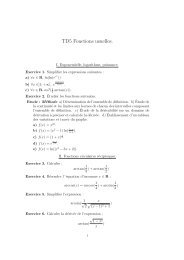
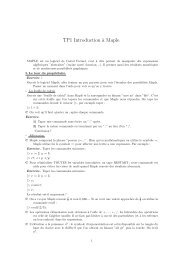
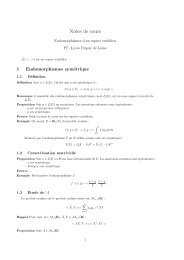

![[http://mp.cpgedupuydelome.fr] édité le 4 juin 2013 Enoncés 1 ...](https://img.yumpu.com/19249082/1/190x135/http-mpcpgedupuydelomefr-edite-le-4-juin-2013-enonces-1-.jpg?quality=85)
